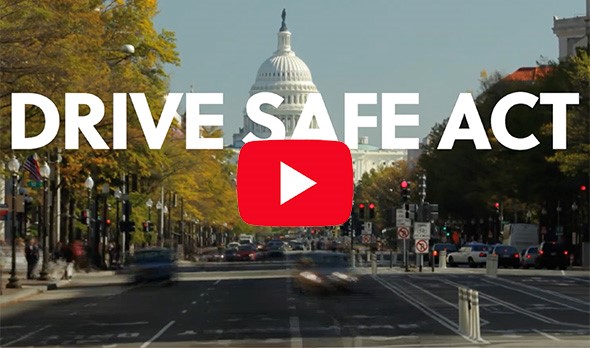Arlington, VA — Today, American Trucking Associations applauded the introduction of the DRIVE Safe Act in both the U.S. House and Senate by a group of bipartisan legislators. The legislation addresses the economy’s growing shortage of professional truck drivers by expanding job opportunities for younger members of the trucking workforce, while also strengthening safety training and technology safeguards for select candidates looking to participate in interstate commerce early in their careers.
The DRIVE-Safe Act was introduced by Sens. Todd Young (R-Indiana), Jon Tester (D-Montana), Joe Manchin (D-West Virginia), Tom Cotton (R-Arkansas), Angus King (I-Maine), Krysten Sinema (D-Arizona), Jerry Moran (R-Kansas) and Jim Inhofe (R-Oklahoma) in the Senate, and by Reps. Trey Hollingsworth (R-Indiana), Jim Cooper (D-Tennessee), Henry Cuellar (D-Texas), Elissa Slotkin (D-Michigan), Jared Golden (D-Maine), Troy Balderson (R-Ohio), Ashley Hinson (R-Iowa), Bruce Westerman (R-Arkansas) and Darin LaHood (R-Illinois) in the House.
While 49 states permit individuals to obtain a commercial driver’s license and operate large commercial vehicles before they turn 21, federal regulations prohibit those same drivers from crossing state lines until they turn 21. These restrictions bar a vital population of job seekers from interstate trucking, exacerbating the driver shortage as qualified candidates are lost to other industries. The DRIVE Safe Act would allow certified CDL holders already permitted to drive intrastate the opportunity to participate in a rigorous apprenticeship program designed to help them master interstate driving, while also promoting enhanced safety training for emerging members of the workforce.
“This bill has strong, bipartisan backing because it’s both common sense and pro-safety,” said ATA President and CEO Chris Spear. “It raises the bar for training standards and safety technology far above what is asked of the thousands of under-21 drivers who are already legally driving commercial vehicles in 49 states today. The DRIVE Safe Act is not a path to allow every young person to drive across state lines, but it envisions creating a safety-centered process for identifying, training and empowering the safest, most responsible 18- to 20-year-olds to more fully participate in our industry. It will create enormous opportunities for countless Americans seeking a high-paying profession without the debt burden that comes with a four-year degree.”
Under the proposed legislation, after a driver meets the requirements currently in place to obtain a CDL, they can then begin a two-step program of additional training, which includes rigorous performance benchmarks. The program requires these drivers to complete at least 400 hours of on-duty time and 240 hours of driving time with an experienced driver in the cab with them. All trucks used for training in the program must be equipped with advanced safety technology including active braking collision mitigation systems, video event capture and a speed governor set at 65 miles per hour or less. Only once all these benchmarks are successfully met will the candidate be permitted to cross state lines.
The truck driver shortage is expected to grow worse in the coming years as more drivers move into retirement and the demand for freight transportation increases. Over the next decade, it’s projected that the trucking industry will need to hire roughly 1.1 million new drivers, or an average of nearly 110,000 per year, to keep up with demand. The federal ban on interstate commerce for under-21 drivers is a major impediment to recruitment, as local in-state routes are generally reserved for seniority.
A coalition of nearly 90 companies and trade associations throughout the supply chain, including manufacturing, agriculture, retail and restaurants, have long supported enactment of the DRIVE-Safe Act.
“The DRIVE-Safe Act comes at a time when the national economy is reeling from pandemic-related job losses,” said Mark S. Allen, President and CEO of the International Foodservice Distributors Association. “At the same time, the pandemic highlighted how essential professional drivers are to our everyday life, increasing the demand for this specific kind of job. The DRIVE-Safe Act will hasten our economic recovery by providing an opportunity for new drivers to enter the workforce while reinforcing a culture of safety far and above current standards.”

